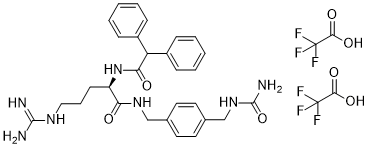| Cas No.: | 191868-14-1 |
| Chemical Name: | BIBO-3304 TFA |
| Synonyms: | BIBO-3304 |
| SMILES: | O=C(N[C@@H](C(NCC1=CC=C(CNC(N)=O)C=C1)=O)CCCNC(N)=N)C(C2=CC=CC=C2)C3=CC=CC=C3.O=C(O)C(F)(F)F.O=C(O)C(F)(F)F |
| Formula: | C33H37F6N7O7 |
| M.Wt: | 757.69 |
| Purity: | >98% |
| Sotrage: | 2 years -20°C Powder, 2 weeks 4°C in DMSO, 6 months -80°C in DMSO |
| Description: | BIBO3304 TFA is a potent, orally active, and selective neuropeptide Y (NPY) Y1 receptor antagonist, with subnanomolar affinity for both the human and the rat Y1 receptor (IC50=0.38 and 0.72 nM, respectively)[1]. |
| In Vivo: | BIBO3304 TFA (30 μg; bilateral paraventricular nucleus injection) attenuates the hyperphagia following fasting[1]. BIBO3304 TFA (15-60 μg) dose-dependently inhibits the feeding reponse mediated by 1 μg NPY[1]. BIBO3304 TFA (0.5 μM; p.o.) significantly increases serum insulin levels[2]. Animal Model: Adult male Chbb:Thom rats weighing between 300 and 340 g[1] Dosage: 30 μg Administration: bilateral paraventricular nucleus injection Result: Attenuated the hyperphagia following fasting, especially during the first 2 h of refeeding. Animal Model: 7-week-old C57BL/6JAusb mice[2] Dosage: 0.5 μM Administration: p.o. Result: Significantly increased serum insulin levels. |
| References: | [1]. Wieland HA, et al. Subtype selectivity of the novel nonpeptide neuropeptide Y Y1 receptor antagonist BIBO 3304 and its effect on feeding in rodents. Br J Pharmacol. 1998 Oct;125(3):549-55. [2]. Loh K, et al. Inhibition of Y1 receptor signaling improves islet transplant outcome. Nat Commun. 2017 Sep 8;8(1):490. |

 To enhance service speed and avoid tariff delays, we've opened a US warehouse. All US orders ship directly from our US facility.
To enhance service speed and avoid tariff delays, we've opened a US warehouse. All US orders ship directly from our US facility.




















